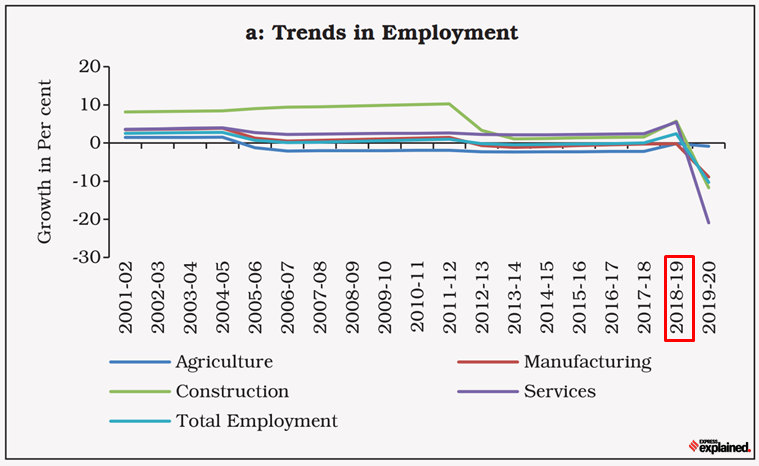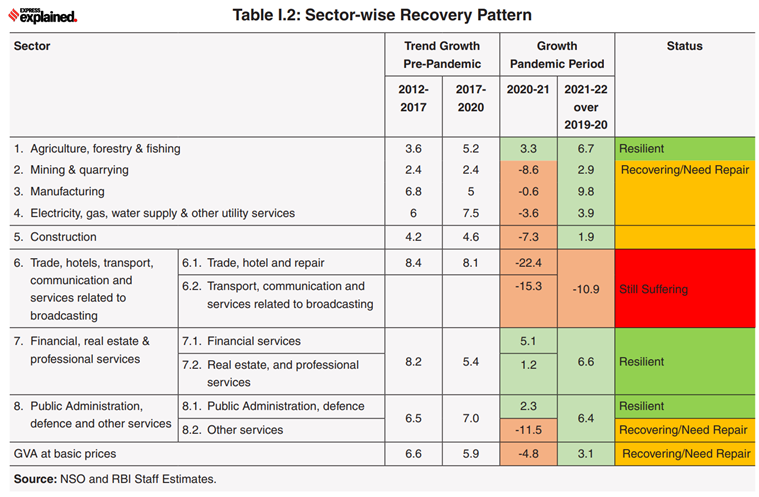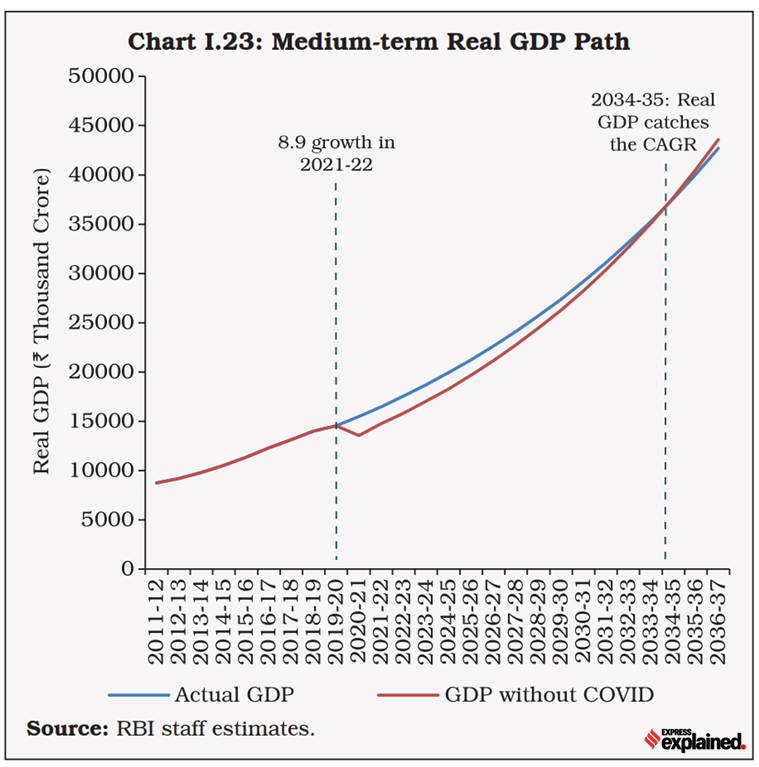ForumIAS announcing GS Foundation Program for UPSC CSE 2025-26 from 19 April. Click Here for more information.
Contents
| For 7PM Editorial Archives click HERE → |
Introduction
The Reserve Bank of India has recently released the Report on Currency and Finance (RCF) 2021-22. The theme of the Report is “Revive and Reconstruct” in the context of nurturing a durable recovery post-COVID and raising trend growth in the medium-term. The Report provides a frank assessment of the state of the Indian economy. It begins with analysis of the economic slowdown prior to the pandemic. It further evaluates the post-Covid scenario, and the challenges facing the economy. One of the observations of the RCF is that ‘India is expected to overcome Covid-19 losses in 2034-35’. This warrants close attention to the concerns highlighted in the report, and its policy prescriptions.
What are the key findings of the Report on Currency and Finance?
General Findings
India witnessed the actual growth rate of (-) 6.6% for 2020-21 and 8.9% for 2021-22. It is expected to overcome COVID-19 losses in 2034-35. For this, it is assumed that there would be a growth rate of 7.2% for 2022-23, and 7.5% beyond that. The RBI said the output losses for individual years have been worked out to INR 19.1 lakh crore, INR 17.1 lakh crore and INR 16.4 lakh crore for 2020- 21, 2021-22 and 2022-23, respectively.
Pre-Pandemic Scenario
India’s economic prospects had worsened even prior to the pandemic, with growth beginning to slow down in 2017-18. The GDP growth between 2017 and 2020 was just 5.7% — exactly the same as it was during 2011-2014. This slowdown, as the report notes, ‘coincided with sluggishness in the labour market’.
Source: Indian Express
The report observes that India’s growth had been driven by private consumption (Private Final Consumption Expenditure, PFCE). However, private consumption has been slowing down since 2016. The report has attributed this to subdued labour market prospects (i.e., unemployment), coupled with household leverage (debt) and domestic shocks. The Private Final Consumption expenditure (PFCE) component had lost its growth momentum sharply — from 7.5% (2014-17) to 6.2% (2017-20).
The Report on Currency and Finance notes that the declining trend in employment started in 2018 and rural wages lost their growth momentum in late 2017. These weaknesses were exacerbated by the COVID-19 pandemic.
Source: Indian Express
Post-Pandemic Scenario
The Indian labour market witnessed a sharp deterioration during the first wave of the pandemic with unemployment rate touching a record high and the labour force participation rate (LFPR) plummeting. The demand for MGNREGA jobs continues to be higher than the pre-Covid levels. The stringent lock-downs may have had a limited impact as India remains second-worst affected country by the pandemic (in terms of number of cases).
The Report on Currency and Finance observes that the economy has staged a quick recovery from the depths seen during the peak of the pandemic. However the recovery has been uneven (or K shaped). Sectors such as trade, hotels, transport, communication and services, which are also labour intensive, have fared poorly.
Source: Indian Express
While the healthier firms have fared better, ‘weak firms remained vulnerable with negative profitability, indicating a divergent recovery within the organised corporate sector’. The toll on the informal sector has been considerably higher.
What are the challenges facing the Indian Economy?
First, there appears to be divergence between the Government’s stand and the picture of the economy shown by the data. This divergence may lead to incorrect policy choices. For instance, in 2019 the government provided a massive Corporate tax cut. It was done to incentivise investments and boost the overall supply in the economy. But the problem in the Indian economy in 2019 was that of faltering consumer demand. Similarly, there is a view that recovery of economy has been uneven and not ‘v-shaped’ as the Government has asserted. This is also evident from the Report on Currency and Finance which notes that the economy will take almost 12 years to recover the losses due to the pandemic.
Source: Indian Express
Second, the pandemic is not yet over and a fresh wave of Covid has hit China, South Korea and several parts of Europe. This may again ignite a new wave of infections in India, thereby creating a pressure on the health care system and overall economy.
Third, with the ongoing Russia-Ukraine conflict, the downward risks to global and domestic growth are getting accentuated through surge in commodity prices and global supply chain disruptions. India too has felt the pressure from the global supply chain disruptions with the supplier’s delivery time falling to its lowest point of 29.5 in April 2020.
Fourth, the RBI assumes that there would be a growth rate of 7.2% for 2022-23, and 7.5% beyond that which maybe optimistic. In all of India’s history, it has registered an average annual GDP growth rate of 7% only during one phase (between 2004-2012).
What are the suggestions to boost economic growth?
First, a feasible range for medium-term steady state GDP growth in India works out to 6.5–8.5%. As per RBI, timely rebalancing of monetary and fiscal policies will likely be the first step in this journey.
Second, price stability is a necessary pre-condition for strong and sustainable growth. Reducing general government debt to below 66% of GDP over the next five years is important to secure India’s medium-term growth prospects.
Third, the Report on Currency and Finance suggests structural reforms for improving the overall economic scenario. This includes: (a) Enhancing access to litigation free low-cost land; (b) Raising the quality of labour through public expenditure on education and health and the Skill India Mission; (c) Scaling up R&D activities with an emphasis on innovation and technology; (d) Creating an enabling environment for startups; (e) Rationalization of subsidies that promote inefficiencies; (f) Encouraging urban agglomerations by improving the housing and physical infrastructure.
Fourth, the PSU banks should not be dependent on the government for recapitalisation. In the medium term, it is necessary to wean away PSBs from their dependence on government recapitalisation; this will be an important pre-condition to achieve greater privatization of the sector. Further, to increase the competition in the banking sector and to introduce innovation, the RBI’s ‘on tap’ licensing policy for universal and small finance banks may be used effectively.
Fifth, Industrial revolution 4.0 and committed transition to a net-zero emission target warrant a policy ecosystem that facilitates provision of adequate access to risk capital and a globally competitive environment for doing business.
Sixth, India’s ongoing and future free trade agreement (FTA) negotiations may focus on transfer of technology and better trade terms for high quality imports from partner countries to improve the outlook for exports and domestic manufacturing.
Conclusion
The government should now focus on the blueprint of reforms proposed in the Report which revolves around seven wheels of economic progress. These are: Aggregate Demand; Aggregate Supply; Institutions, Intermediaries and Markets; Macroeconomic Stability and Policy Coordination; Productivity and Technological Progress; and Structural change and Sustainability.
Source: Indian Express, Indian Express, Indian Express








